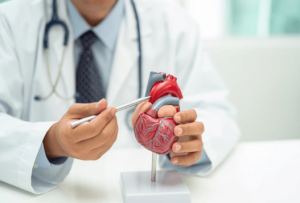4.1.3 Preventing and Treating Acute Exacerbations of Chronic Heart Failure
Acute Heart Failure
 |
 |
 |
Causes of Acute Exacerbations of Chronic Heart Failure
Medications that can Exacerbate Chronic Heart Failure
Various medications for a variety of different indications can cause or exacerbate heart failure.
These include the non-dihydropyridine calcium channel blockers, verapamil and diltiazem. These can further depress myocardial function in patients with heart failure and must never be used in combination with beta blockers.
Beta blockers, as we said earlier, should not be used in patients with heart failure unless they are clinically stable and not commenced until there are no signs of congestion. If the patient does start to develop signs of a mild heart failure exacerbation, then the beta blocker might be continued while we increase the diuretic dose, but if it is a more serious heart failure exacerbation then the beta blocker should certainly be stopped as it will antagonise the effects of the drugs used to treat a severe acute heart failure exacerbations.
Non-steroidal anti-inflammatory drugs (NSAIDs) are another really important group of drugs to avoid in heart failure, because they can commonly cause sodium and water retention.
Other medications that can exacerbate heart failure are listed below:
Diuretics in Acute Heart Failure
First line pharmacological therapy in acute heart failure is intravenous furosemide, to relieve signs and symptoms of congestion. Remember these include pulmonary congestion, peripheral oedema, hepatic congestion, and ascites. The intravenous route is needed because absorption issues are associated with the oral route such as gastrointestinal hypoperfusion and oedema round the bowel as well. The IV route also enables a much faster onset of action.
Since diuretics can cause blood pressure to decrease, we must ensure that the patient is maintaining adequate tissue perfusion and that their blood pressure is holding stable before giving the diuretic. We should also consider the dose. If a patient has developed fluid overload because of acute heart failure despite a regular oral diuretic dose, then we know there will be no point giving an IV dose that is equivalent to less than their oral dose. It must be at least equivalent, in most cases it will be increased.
So it is important that you remember that the oral bioavailability of furosemide is about 50%. Meaning 20mg IV furosemide is about equivalent to 50mg of oral furosemide. This is also important to remember when it comes time to switch back to oral dosing from IV dosing.
For example, If the patient normally takes 80mg of oral furosemide twice a day (at morning and midday), then the equivalent IV dose is 40mg BD.
Usually, we want to increase the dose to get rid of the extra fluid that has accumulated, so we could prescribe 2x the usual dose which is equal to 80mg IV BD.
Intravenous Vasodilators
Intravenous vasodilators, such as a continuous glyceryl trinitrate infusion or a sodium nitroprusside infusion, may be considered in patients with acute heart failure if their systolic blood pressure is greater than 90mmHg. The rationale is to relieve symptoms of congestion by optimising preload and reducing afterload to hopefully increase stroke volume. But there is only low-quality evidence to support their use as part of the treatment of acute heart failure in practice. There is a very high risk of lowering blood pressure too low, so blood pressure is something that must be monitored very closely if intravenous vasodilators are being considered.
Patients receiving intravenous vasodilator therapy will be admitted to a high dependency unit such as the coronary care unit or intensive care unit, where there are facilities and nurse-patient ratios that can facilitate the high-level monitoring that is required. Generally, if an intravenous vasodilator is going to be used, glyceryl trinitrate will be chosen, because there are more issues associated with sodium nitroprusside, including a greater risk of lowering BP too dramatically. Sodium nitroprusside can also be associated with rebound hypertension if it is stopped too quickly.
Inotropic Therapy
An inotrope is a substance that affects the force of muscular contractions. Positive inotropes increase the strength of muscular contractions. Positive inotropes are used in acute heart failure if there are signs and symptoms of peripheral hypoperfusion due to inadequate cardiac output (usually accompanied by a systolic blood pressure of less than 90mmHg) and congestion refractory to diuretic treatment. The aim of inotropic therapy in this setting is to improve stroke volume so as to improve cardiac output, which will ultimately help to improve symptoms and end-organ function. However, these drugs are only for short term use while other measures are being used to help the patient recover from their haemodynamic compromise. Like the intravenous vasodilators, all of the available inotropic agents require continuous cardiac monitoring in a high dependency unit such as the coronary care unit or intensive care unit.
Beta blockers must be ceased whenever inotropes are required.
Hopefully, you are starting to understand the rationale for these treatments and understand that the goal is to maintain cardiac output and tissue perfusion. Ideally, we achieve this by using an inotrope with vasodilatory activity (e.g., dobutamine). But if this doesn’t work, then we can consider one with vasopressor activity to help increase blood pressure a little but not so much that increased afterload reduces the ejection fraction even more. Extra caution should be used with inotropes that have vasopressor activity (those being dopamine, noradrenaline, and adrenaline) as vasopressor activity means increased afterload which can further reduce ejection fraction and tissue perfusion.
Download the lecture notes here:
COMMONWEALTH OF AUSTRALIA Copyright Regulations 1969 WARNING
This material has been reproduced and communicated to you by or on behalf of James Cook University in accordance with section 113P of the Copyright Act 1969 (Act).
The material in this communication may be subject to copyright under the Act. Any further reproduction or communication of this material by you may be the subject of copyright protection under the Act. Do not remove this notice.
